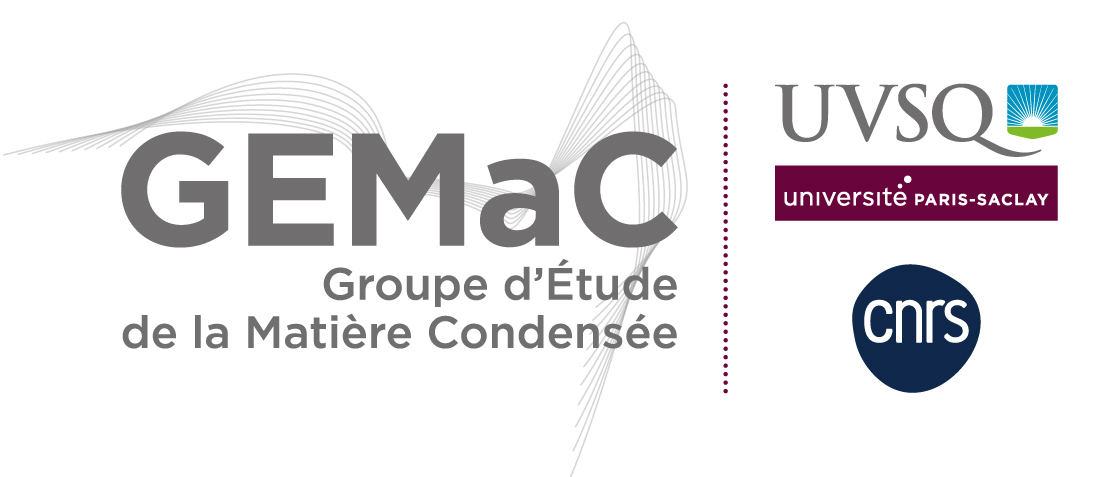Vous êtes ici : GEMACFRSéminaires et colloques
- Partager cette page :
- Version PDF
First stages of diamond BEN nucleation on iridium: an in situ study by electron spectroscopies
This seminar presents the study of the first stages of diamond nucleation on iridium which is useful for the improvement of performances of large area diamond devices for electronic and detection applications.
le 16 décembre 2009
le mercredi 16 décembre 2009 à 10h
CNRS
1, Place Aristide Briand
92195 MEUDON Cedex
1, Place Aristide Briand
92195 MEUDON Cedex
Synthesis of highly oriented diamond thin films on hetero-substrates and the control of their doping are required towards improved performances of large area diamond devices for electronic and detection applications. The bias enhanced nucleation (BEN) treatment coupled with the MPCVD technique is the most efficient for diamond heteroepitaxy. At the present stage, the best oriented diamond films have been deposited on iridium [1], [2].
Compared to other hetero-substrates, iridium presents favourable physical properties for diamond epitaxy (reduced lattice misfit, cubic structure and high melting point). Moreover, in CVD deposition, the substrate interaction with reactive carbon species is a key parameter which governs the interface formation and greatly influences the nucleation mechanisms. The weak interaction of iridium with carbon (no carbide formation) leads to a unique nucleation scheme [3] [4].
The knowledge of the surface evolutions induced by plasma exposures is essential to control the diamond / iridium interface. In this study, the first stages of diamond nucleation have been analysed step by step using different in situ techniques in a MPCVD reactor connected to an UHV analysis chamber. More precisely, this study will follow chemical evolutions of the iridium (100) buffer layer on SrTiO3 (100) along the successive steps (stabilisation under H2/CH4 plasma, short bias enhanced nucleation and early stages of growth). This allows the fine investigation of the deposited carbon layers and especially at the first stages of diamond nucleation by X-ray Photoelectron Spectroscopy (XPS) and Auger Electron Spectroscopy (AES). As a complement, ex-situ SEM analysis will be presented.
[1] K. Ohtsuka et al. , Jpn. J. Appl., Phys. Vol.35 (1996).+
[2] M. Schreck et al. , Appl. Phys., Lett. 74,5 (1998).
[3] M. Schreck et al. , Dia. Rel. Mat., 12,3-7 (2003).
[4] M. J. Verstraete et al, Appl. Phys., Lett. 86 (2005).
Compared to other hetero-substrates, iridium presents favourable physical properties for diamond epitaxy (reduced lattice misfit, cubic structure and high melting point). Moreover, in CVD deposition, the substrate interaction with reactive carbon species is a key parameter which governs the interface formation and greatly influences the nucleation mechanisms. The weak interaction of iridium with carbon (no carbide formation) leads to a unique nucleation scheme [3] [4].
The knowledge of the surface evolutions induced by plasma exposures is essential to control the diamond / iridium interface. In this study, the first stages of diamond nucleation have been analysed step by step using different in situ techniques in a MPCVD reactor connected to an UHV analysis chamber. More precisely, this study will follow chemical evolutions of the iridium (100) buffer layer on SrTiO3 (100) along the successive steps (stabilisation under H2/CH4 plasma, short bias enhanced nucleation and early stages of growth). This allows the fine investigation of the deposited carbon layers and especially at the first stages of diamond nucleation by X-ray Photoelectron Spectroscopy (XPS) and Auger Electron Spectroscopy (AES). As a complement, ex-situ SEM analysis will be presented.
[1] K. Ohtsuka et al. , Jpn. J. Appl., Phys. Vol.35 (1996).+
[2] M. Schreck et al. , Appl. Phys., Lett. 74,5 (1998).
[3] M. Schreck et al. , Dia. Rel. Mat., 12,3-7 (2003).
[4] M. J. Verstraete et al, Appl. Phys., Lett. 86 (2005).
Informations complémentaires
Séminaire organisé par Monsieur Anthony Chavanne, de l'Equipe “Diamant pour l’électronique”.
 Contact :
Contact :
Marie-Amandine Pinault - Chercheure
Tél. : 01 45 07 53 29
marie-amandine.pinault@cnrs-bellevue.fr
 Contact :
Contact : Marie-Amandine Pinault - Chercheure
Tél. : 01 45 07 53 29
marie-amandine.pinault@cnrs-bellevue.fr
- Revenir à la liste complète des séminaires





